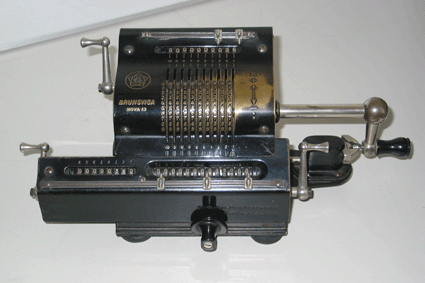The Brunsviga Nova 13 Mechanical Calculator

Photo: University of Amsterdam Computing Museum).
The Brunsviga Nova 13, Olympia Werke AG, Wilhemshaven, circa 1920, entirely mechanical, typical of computing equipment used at Columbia University in the mid-1920s. Brunsviga and Millionaire calculators are listed in the 1924-1925 Columbia University Catalogue in the Social Science section (the specific Brunsviga models are not stated but the Nova 13 is a likely candidate).
An adding machine could do only sums. A calculator could also multiply and possibly divide (of course later calculators could do more than that). Multiplication was performed by entering the multiplicand and then turning the crank "multiplier" times (or vice-versa). Models like the Brunsviga allowed certain crank-saving techniques. For example, to multiply 567 by 32:
- Pull the levers down to 567 (the multiplicand).
- Pull the knob on the large lever handle on the right outwards and rotate once.
- Rest the handle in the claws. Center and lower rows now read 567; top row reads 1.
- Rotate handle once again; center row reads 567 and lower reads 1134. Top row reads 2, noting the number of operations (2 x 567 = 1134).
- Slide the bottom knob to the left to shift the middle number (576) one place, thus multiplying it by 10: 5670.
- Rotate the handle 3 times, thus adding three copies of 5670 to 1134 and obtaining the product, 18144, in the bottom row.
Here are some additional Brunsviga views, from Paula Koivunen (koivunen.paula@gmail.com) in Finland, April 2008, of her father's Brunsviga Nova 13, serial number 115117 (click on the thumbnails to see larger versions):
The Millionaire was a bit more efficent, requiring only one crank turn per multiplier digit; the increased efficiency was accomplished with (mechanical) lookup tables; thus it could multiply a long number by a single digit n directly, rather than by adding the number to itself n times.
See the 1933-34 section of the Timeline to learn how the laborious, time-consuming, and error-prone calculator-based methods for performing complex scientific computations prompted a Columbia Astronomy professor, Wallace Eckert, to design and build (in Pupin Hall) an electro-mechanical "network" of devices capable of automated mathematical computation under program control -- arguably the first computer.
More Brunsviga and mechanical calculator links (all working as of 27 March 2021):
- CLICK HERE to read the instruction manual for a later Brunsviga hand-cranked model, the 13 RM.
- CLICK HERE, HERE, HERE, and HERE, to see more Brunsviga models.
- Vintage Calculators Web Museum.
- The Collection of Calculating Devices.
- IBM "Attic" Artifacts, Volume 3 (includes several Brunsvigas and other model mechanical calculators).





